“The creatures outside looked from pig to man, and from man to pig, and from pig to man again; but already it was impossible to say which was which.”
— George Orwell, “Animal Farm”
LAGRANGE, Ind. — I am stuffed into the front of a pickup, rumbling up a muddy incline. Thick woods flank the road on either side; they are flooded with hogs.
At the wheel is Greg Gunthorp, a hardworking farmer who folds sharp opinions into an agreeable, down-to-earth Midwestern affect — the archetypical “guy you’d want to have a beer with.” If you only remember one thing about Greg, make it this: He is a fourth-generation pig farmer, and he’ll be damned if he’s the last. He mentions this at least three times.
In Greg’s case, this quaint intergenerational pride is hard-earned. He set off from his parents’ farm to start his own venture in 1994, right at the maw of an industry-wide extinction event. In 1998, undue market optimism converged with creeping industrialization to spark a glut of overproduction that drove hog prices to their lowest levels since the Great Depression. Greg says that he and his wife were forced to sell pigs at a low of 5 cents a pound; across the industry, farmers collectively lost some $2.6 billion.
The hog price collapse pushed a wave of independent farmers out of the business, accelerating a creep of corporate consolidation that saw the number of American hog farms drop by over 70% from 1992 to 2009. Today’s holdouts increasingly live under a kind of corporate feudalism, with many on contract to maintain corporate-owned hogs according to specification. Farmers assume debts and liabilities while the likes of Tyson, Smithfield and JBS reap the bulk of the profits.
Surviving vertical integration is one thing, but Greg is among a tiny handful of pig farmers to have done so without severely reforming the practices of earlier generations. Faced with the stringent demands of a scaled-up and heavily centralized market, barebones mixed-species and rotational grazing techniques quickly went from tenuous to unviable. Modern farmers now largely keep hogs in cramped indoor facilities suspended over vats of fermenting feces without access to sunlight, bedding or dirt.
Factory-farm confinement doesn’t just serve as fertile ground for propagating diseases and infectious bacteria — it also pollutes the air, soil and water of surrounding communities. Industrialization has geographically restructured hog farming around major processing arteries, most notably in Iowa, where pigs outnumber people seven to one and produce a volume of waste equivalent to 84 million humans — more than 25 times the state population. Research suggests that concentrated feeding operations heighten their neighbors’ risk of certain respiratory and gastrointestinal problems; one Iowa State University study determined that their emissions “may constitute a public health hazard.”
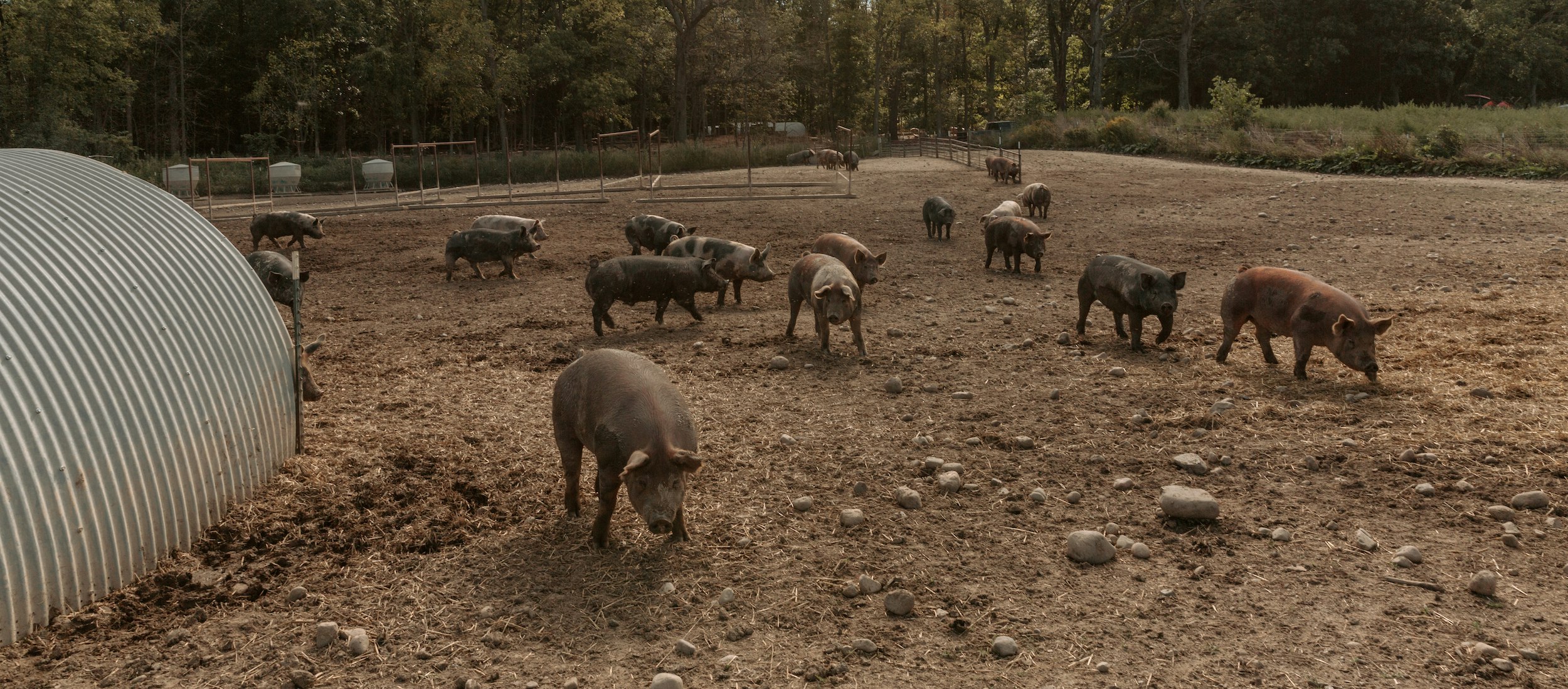
Pigs are widely associated with an overpowering stench, but the characteristic smell has more to do with how we keep them than the animals themselves. At Gunthorp Farms, it is imperceptible beyond grappling range. Greg has managed to stay afloat on roughly 3,000 hogs per year by reabsorbing once-regional supply chain elements that now aggressively squeeze profits from farmers, taking the unusual step of running a small on-site processing facility. This allows him to get hogs to market without relying on corporate middlemen, but it also brings plenty of logistical headaches. When he started building the plant, over 20 years ago, neighboring hog farmers thought he was insane. At the time, that was a reasonable evaluation. Today, they are all out of business.
Greg is taking me around his farrowing lots, 40 acres of forest reserved for pregnant sows to nest, give birth and stay with their piglets for their first six to eight weeks of life. As we approach, we see that a litter of piglets has dug out from under the fencing around their enclosure and are now darting between the bushes up ahead. They freeze, staring, taunting us, then bolt for cover in unison.
Most U.S. farms keep sows in farrowing and gestation crates, coffin-sized enclosures that are too small to physically turn around in. Piglets suckle through bars, and sows are often covered in sores or left to lie on broken legs. Greg, meanwhile, battles to restrain pigs to a property of some 270 acres. He isn’t worried about the small ones — their mothers ensure they don’t go far. But long-term escapes are not unheard of. “They’ve been smart enough to figure out that they can grab an electric fence post without getting shocked, pick it up, turn it sideways and take down the fence,” he says. Greg’s pigs have burrowed under or leaped over the walls of their enclosures; once, he found one lounging by a river an entire year after it had gone missing.
Greg pulls over and his dog Daisy explodes out the door. The piglets lead her on a chase, leaping in tandem and flowing around trees with incomprehensible coordination. They seem to enjoy it, but one of the sows belts a sequence of grunts from inside the enclosure. “That noise is for their babies,” Greg says. The piglets snap to attention and bolt back under the fence.
Hogs produce a range of vocalizations, and Greg can tell some of them apart. Aside from the baby-call, there is a whining “holler” that means “I’m hungry and want attention”; an aggressive screech to issue a challenge; a mild, persistent grunt that serves as a greeting; and a sharp squeal that signals pain, fear or stress. As squeals echo through the forest, Greg notes a sharp one. “They make that sound a lot after we take away their babies,” he says. “They were just moved to the finishing pasture.”
The piglets continue to play on their side of the enclosure, with rival liters squaring off and weaving around the trees. These woods are so full of joy that it is easy to forget: Every one of them is ultimately being raised for slaughter. They will reside in the finishing lots until reaching maturity at seven to eight months of age. Then, every Thursday, a few dozen will be rounded up for one last move to the holding pens behind Greg’s processing site. There, the harsh realities of livestock farming become unavoidable.
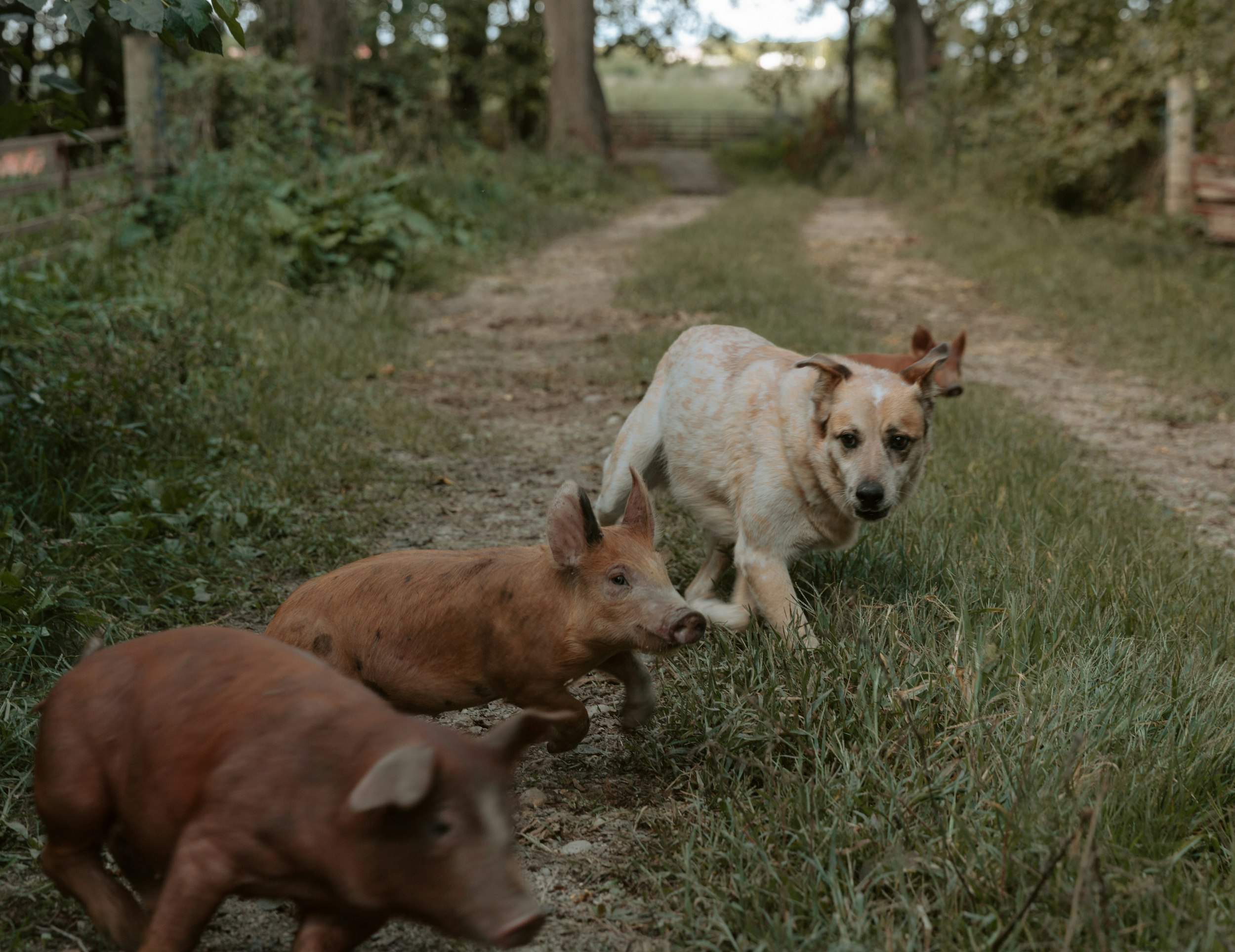

Viewed exclusively through the prism of inevitable slaughter, the value of “ethical” livestock treatment can feel murky. But if Greg’s farm is a window into disappearing agricultural practices, it also preserves a range of hog behaviors that are widely suppressed in commercial facilities. Up close, the details of these lives illuminate the gaping chasm between a cage and a pasture.
“I just think that pigs, out of all the farm animals, are intelligent enough that they shouldn’t be kept in a cage or stuck in a barn for their whole lives,” Greg says. “They’re smart enough to know they shouldn’t be there.”
Over the past few decades, research has demonstrated pigs’ capacity to comprehend symbolic language, plan for the future and discern the intentions of others. Studies have found them to rival chimpanzees in their ability to learn and play joystick-operated video games, despite the fact that their feet and snouts are inevitably less adept at handling the mechanisms. “The average intelligence of a pig on our farm is somewhere between a four-year-old and a fourth-grader,” says Greg, who insists that humans have not grasped the depth of their internal lives.
Measuring nonhuman intelligence is a sticky business — we tend to emphasize traits that resemble our own — but those who try typically categorize swine alongside dolphins, elephants and higher primates in terms of memory, spatial reasoning and capacity for abstract thought. Pigs bore easily and show a clear preference for novelty, and perhaps more impressive than their puzzle-solving skills are their capacities for social manipulation and “Machiavellian intelligence,” hypothesized as a prime evolutionary driver of advanced cognition. A 2000 study required pigs to forage for hidden food in pairs, with one informed of the food’s location in advance and the other left in the dark. The unaware hogs first learned to follow their partners to the food and attempt to displace them; then, informed pigs learned to alter their behavior, concealing their proximity to and anticipation of the food. Both adaptations suggest a capacity to imagine outside perspectives and a complex understanding of the self in relation to others.
Pigs possess a level of cognition that humans easily identify with, but it would be difficult to glean in an industrial context. There they lack proper socialization, external stimuli or much environment to engage with at all. Tighter space also means more competition, driving hogs toward violent and even self-harming behaviors like banging their heads, gnawing at metal bars and biting each other’s tails.
The industry tends to meet the ill effects of excessive restraint with even more restraint, ironically citing concern for hogs’ safety. Farrowing crates, for example, ostensibly “protect” piglets from their mothers, who under confined conditions frequently become disinterested in their children and crush them to death. Pigs’ tails are clipped to “protect” them from getting bit, and their teeth are removed to “protect” them from biting others. Nose rings are designed to discourage natural rooting instincts by making them painful.
It is hard to have a detailed public conversation about these conditions in part because the industry takes pains to shield them from public view. In January 2018, Smithfield — the largest U.S. hog producer, with a 15% market share — claimed to have phased out gestation crates in favor of a “group housing” model with limited crating. Several months later, the animal welfare group Direct Action Everywhere (DxE) published findings from a lengthy investigation alleging that Smithfield still used gestation crates for sows as well as farrowing crates, only slightly larger, for recent mothers. “In virtually every instance where we’ve exposed a factory farm, they claim there is a mythical ‘humane barn’ where the animals were well treated,” DxE co-founder Wayne Hsiung said in an interview with Vox. “The reality is that they must do this because the public does not have a stomach for animal torture.”
Greg believes that the traumas of industrial confinement are passed down through generations. He occasionally buys commercial breeding sows, but prefers not to, claiming that they socialize poorly and do not know how to make proper nests. “If you go to an industrial farm, look into the pigs’ eyes,” he tells me. “Maybe I read too much into it, but they look clinically depressed.”
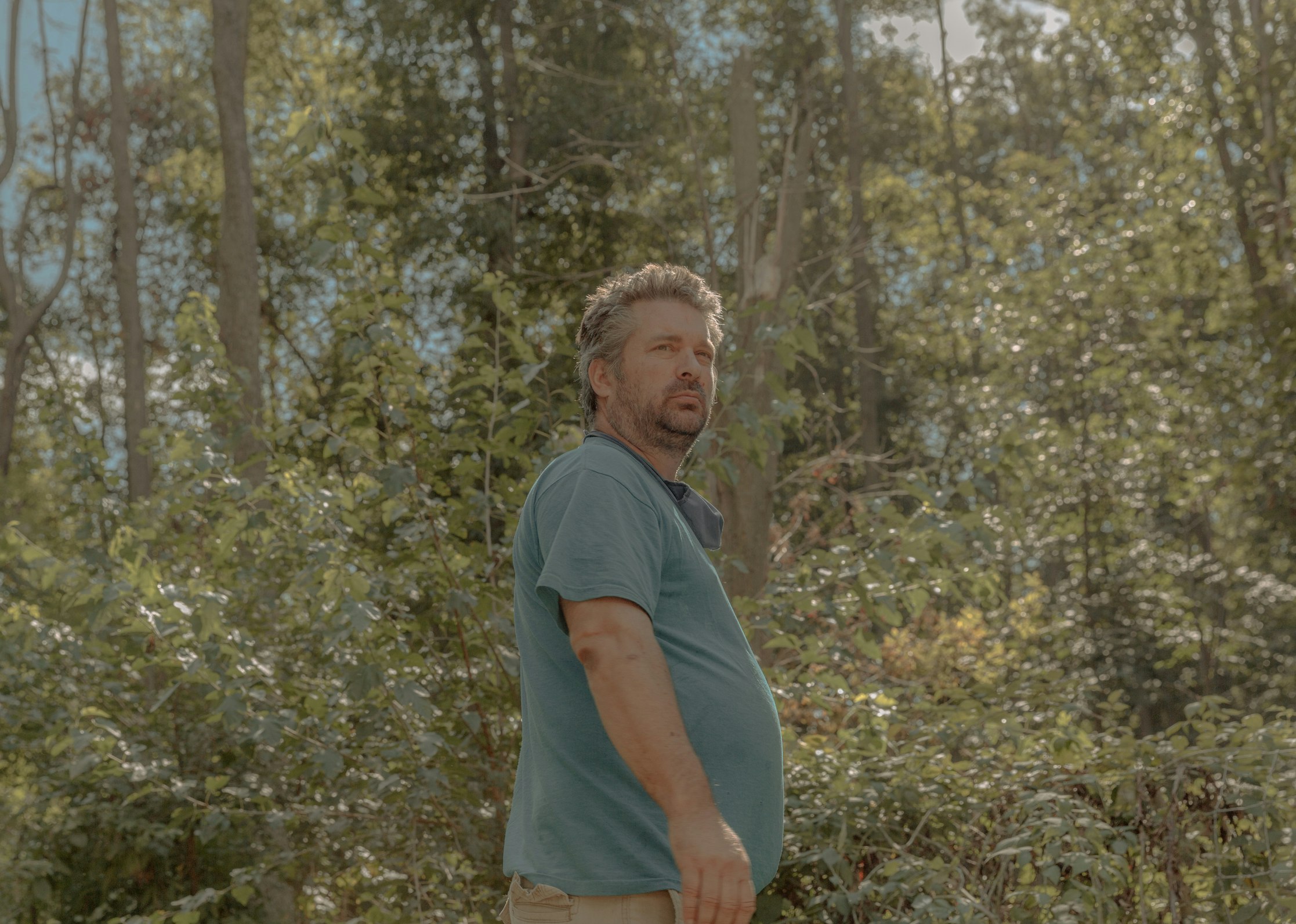
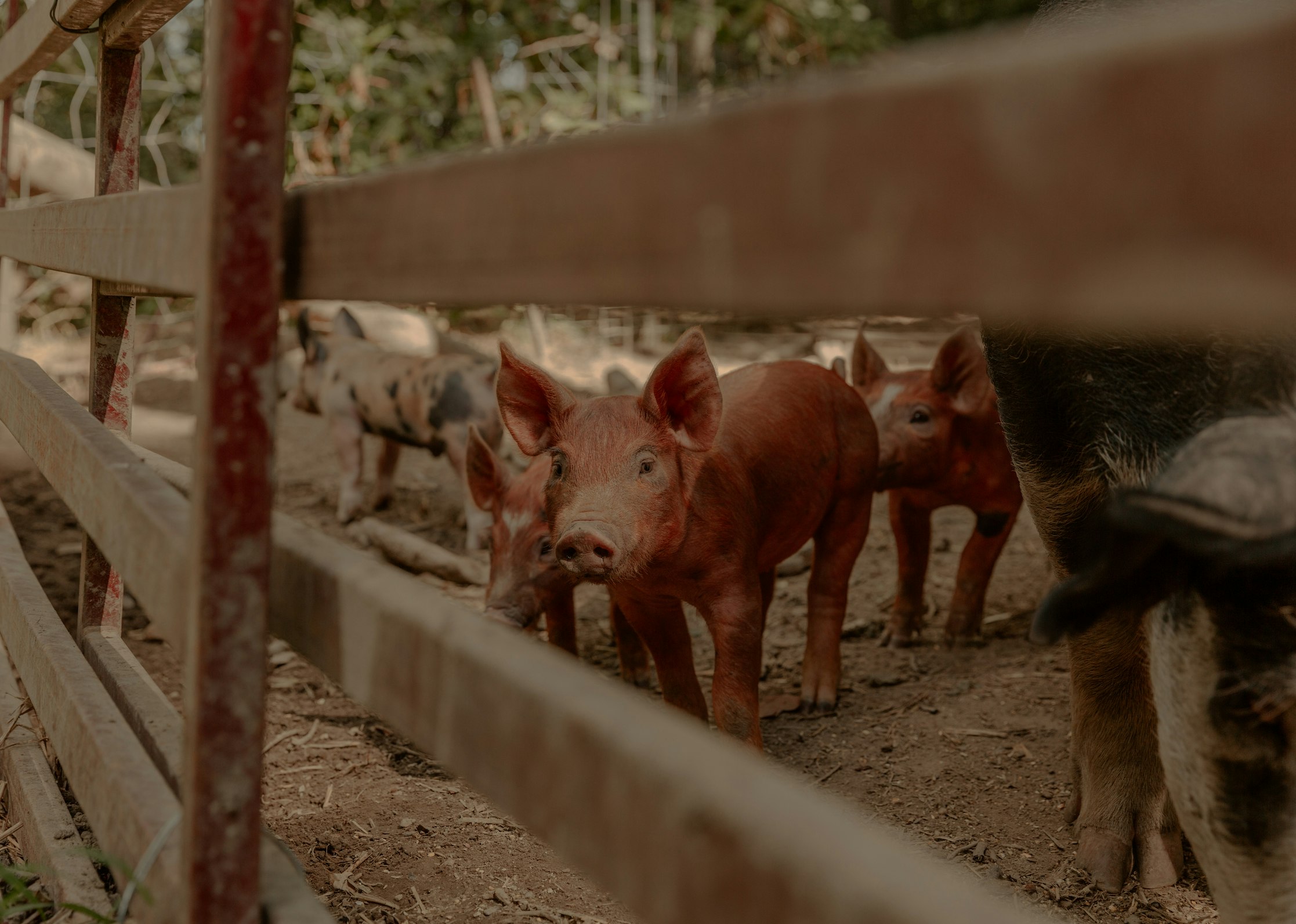
I yield shotgun to Daisy and ride in the truck bed on the way to one of Greg’s finishing lots. The trip is short. As we arrive it strikes me that, every once in a while, these hogs may actually hear their mothers howling with grief over their forced separation. Even under dark circumstances, the pasture seems to confer a relative measure of dignity.
Greg’s finishing lots trade the forest for open hills, ranging between five and 13 acres. The one we visit sports a striking centerpiece: an expansive mud bath, crudely irrigated from natural puddles. The landscape is teeming with other evidence of the pigs’ exploits. Tree bark is worn down from rubbing; rooting holes show the work of shovel-like snouts. Earlier, Greg pointed out that some of his sows decorate their arched metal housing structures with piles of sticks and logs. When we show up at the finishing lot, one of the hogs is frantically tearing down a pole-mounted tarp.
Pastured hogs can cause significant environmental damage without proper management, which is why Greg rotates his plots, reseeds them after use and allows them to lay fallow for half of the year. This gives the foliage time to regrow, ensuring a steady supply of clover, alfalfa, orchard grass, roots and fungi for the hogs to forage as a supplement to their diet. It also means that hogs play a long-term role in soil maintenance, turning it over, removing invasive species and exhuming dead roots and stumps.
The pigs stand alert when I climb out of the truck bed and enter the enclosure, clearly nervous about my presence. “They’d be a lot more skittish if I wasn’t here right now,” Greg says.
After observing his body language, the pigs approach slowly. As they do, a complex hierarchy emerges: Most of them are organized into discernable subgroups, each with its own leaders and followers. One particularly bold quartet leads a cautious advance through scattered grunts and shuffling feet, testing the waters and signaling confidence to others in the rear. After a thorough sniffing, they chew on my shoelaces and rub mud all over my pants. The broader group encircles me, and I notice for the first time that pigs wag their curly tails in much the same way as dogs.

As my novelty subsides the pigs return their attention to one another, exchanging glances, grunts and subtle shifts in posture, occasionally mirroring each other’s movements. Then, as the sun climbs higher, they get lazy. Hogs can only sweat through their noses, and don’t handle heat well. A few retreat to their shelters but others line up at the mud pit, descending one at a time, chest first, submerging and then rotating their bodies with ritualistic precision. Mud clings to their bodies like wet paint. They wriggle and wallow. One blows bubbles in the thickened water. For another moment, the slaughter fades away.
In the early 1980s, there were over 600,000 hog farms in the U.S. Today, the official count hovers around 60,000, but the actual number of independent farmers is certainly far lower, as this includes corporate-owned farms and contract workers. On the processing side, just 15 multinational-owned plants account for 60% of U.S. pork production capacity. “When I was young, most farms around here were between 400 and 450 acres,” Greg tells me over dinner at a local farm-to-table restaurant that serves his meat. “They had dairy cows, sows or sometimes both. Those are virtually all gone. The next county over is down to four dairy farms. When I was little, there were 400. Pigs are similar numbers.”
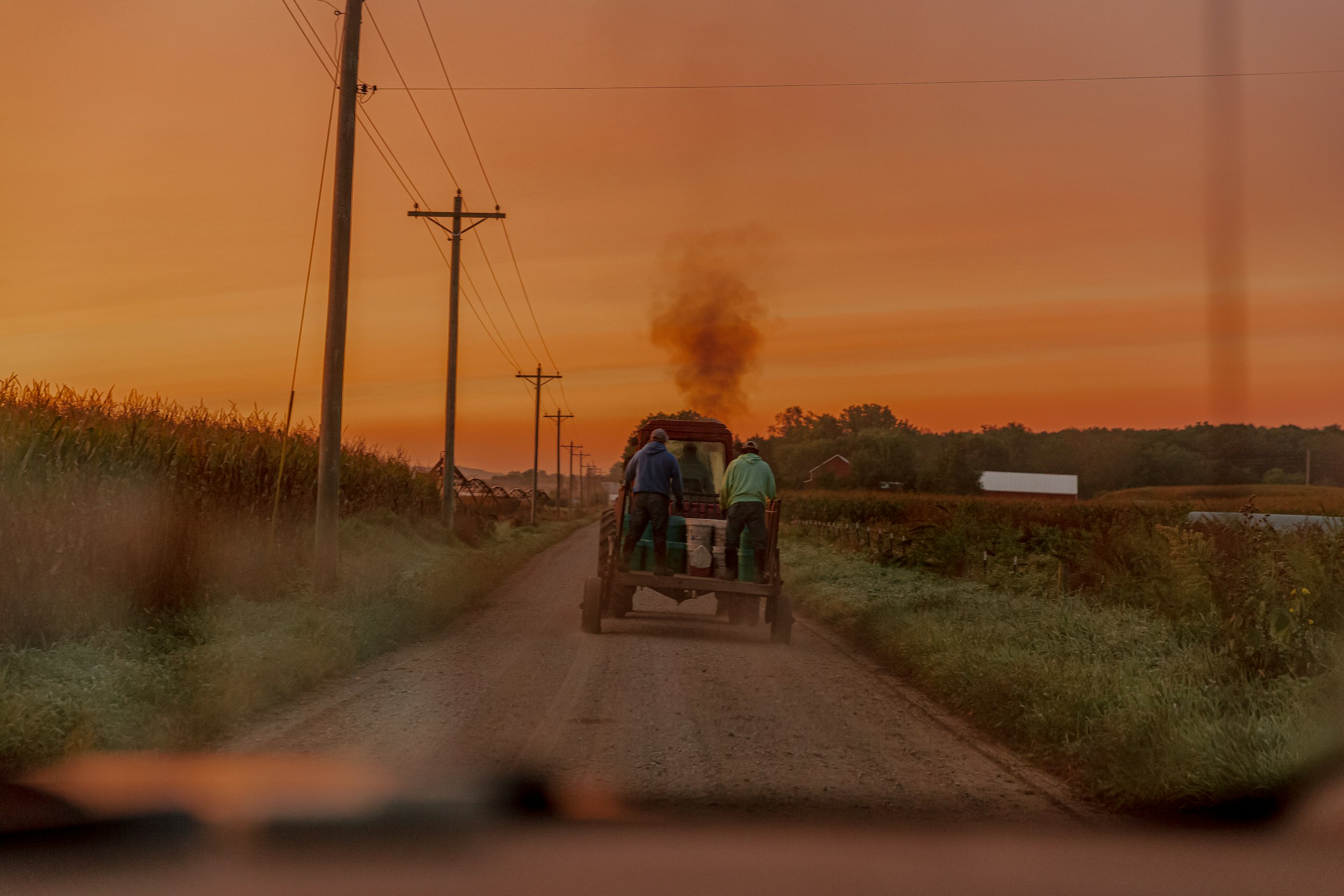
Corporate capture of the pork industry, and American agriculture writ large, initially drove down prices. Now that just 40 massive “farms” account for two-thirds of the country’s hogs, their dominant market position serves to guard profits from small-scale farmers, processing-plant workers, consumers and of course the animals themselves.
With climate change pushing agricultural reform to the fore, recent years have seen significant conversation about the feasibility of regenerative agriculture, a conservation approach to food systems that aims to offset the environmental impacts of large-scale farming with targeted ecological interventions. Greg is no crusading activist, but his business abides by many concepts that regenerative agriculture advocates advance to maintain biodiversity and topsoil health, like rotating pastured livestock. These methods could theoretically be incorporated into a crop rotation, potentially creating an economic incentive for more sustainable practices.
But while Greg’s farm might be a model for pork production under a different economic regime, it is not one that the average farmer could simply walk into today. On-site processing is expensive and risky, something that Greg was able to ease into as the older model of meat production was still dissolving in real-time. His pork retails at double or three times the rate of typical products. The prices aren’t astronomical, but the difference is enough to limit him to a niche market. Herein lies the central argument levied against regenerative agriculture, that it presents an inefficient use of land and undesirable economic outcomes that would make meat less widely available.
Many Americans consider products primarily in terms of price, and it’s not exactly their fault: Global supply chains are inherently opaque, and almost impossible to evaluate on a case-by-case basis. Retail is thus an uphill battle for Greg, who estimates that 75-80% of his business depends on high-end regional restaurants — the restaurateur Rick Bayless has been a longtime customer, for example, especially helping Greg through the early years. This is a small, hyper-competitive market, dependent on individual relationships and woefully unfit to influence industry-wide trends. And even in that limited context, staying in business has been a decades-long grind. When COVID torpedoed the restaurant industry, Greg thought he was done for. It was then that he stopped farming chickens, which he previously raised and produced on-site. (He still does turkeys around Thanksgiving.)
American livestock farms could look a lot more like Greg’s if people saw the change as desirable enough to curb consumption. But with profit at the center of debate, the deck is stacked in the industry’s favor. The market is unlikely to yield to such shifts on its own.
Greg doesn’t see life getting easier for independent farmers, but he trusts the next generation. Young people are abandoning intergenerational family farms across the country at an unprecedented rate, which Greg attributes to the soulless, ungratifying nature of industrialized agriculture. His 24-year-old son Evan, however, has been heavily involved in the day-to-day operation of Gunthorp Farms for years, and is poised to take over when the time comes.
“I could make twice as much working half the hours if I called it quits,” Evan tells me. “But there’s value in this.”
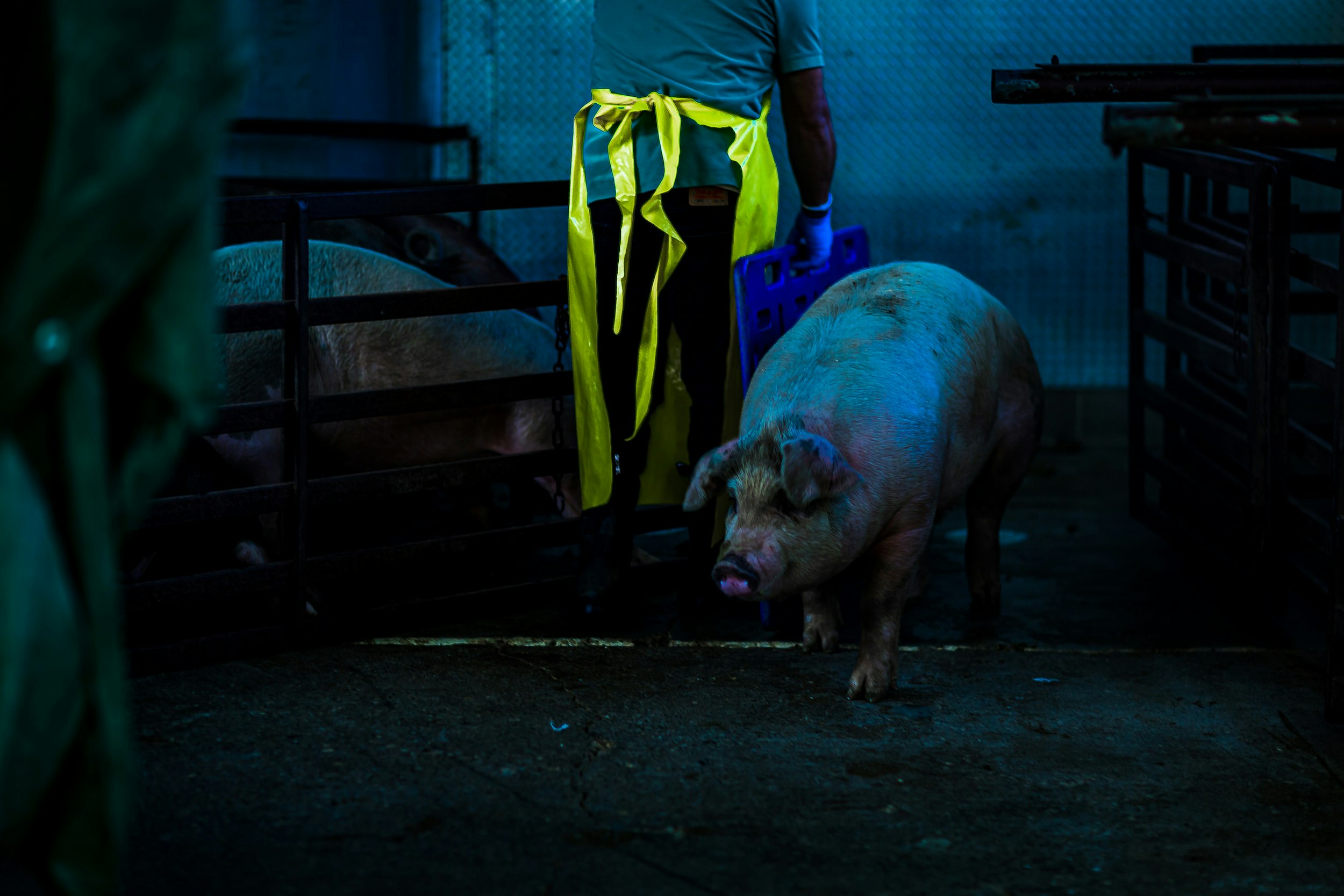
At 6:30 a.m. the next day, Greg is tossing hickory and applewood logs into the smokehouse stove. It’s slaughter day, and 47 pigs are waiting in a holding area behind the processing facility, standing under the exact same style of arched metal shelter that they have known since birth. As with the hogs from yesterday, they are timid at first, but soon yield to curiosity and accept some rubs.
Greg does not enjoy the slaughter — “If I had to personally kill them every week,” he tells me, “I’d quit raising them” — but he accepts it. He has an almost spiritual relationship to pork, seeing the life behind it as a path to respecting the finished product.
In the slaughter room, Greg warns us where not to stand. “This spot will get covered with hair, and this’ll get covered with blood.” All hands are on deck, with workers grouped into a small assembly line.
The process is clinical, hard to process in the moment except in literal terms. First, each pig is led into a small holding crate — subjected to a tight enclosure for the first time in its final moments of life. Then, one worker delivers a 480-volt shock through the animal’s brain, knocking it unconscious and roiling its body with muscle spasms. Once these abate, another worker steps in to cut the pig’s neck at the midline.
From there it is hung up on a winch to bleed out, tumbled over razors on a de-hairing machine, shaved, torched, sanitized, incised at various locations and finally eviscerated. Along with the killing incision, evisceration is the most delicate stage of this process. Today, as usual, that station is manned by Evan, who is overseeing the entire operation. An optimized, scaled-up industrial processing plant goes through more than 1,000 swine an hour. At Gunthorp Farms, that volume takes months. Today, Evan plans to process 47 in four.
The beginning of the assembly line is visible from the holding area with the live pigs; the killing incision is obstructed from view, but the blood is soon thick enough to cover the floor. It’s not pretty, but at least the hogs are not subjected to the stressful transportation and unfamiliar holding environments that centralized processing plants entail. I watch for signs of anxiety, shocked at how calm they seem.
Cattle are so stressed going to slaughter that beef plants need to carefully shield the sight and smell of what’s coming, but some of Greg’s hogs are actually lapping blood up off the ground. It would be easy to take this as proof that they don’t understand what’s coming, but Greg believes that they do.

From animal welfare to socially distributed economic and environmental tolls, most ills of industrial livestock farming run downstream of the all-flattening profit motive. Meaningful reform would need to address structural power, likely breaking up the hyper-consolidated industrial meat production system. Returning to a federated system of smaller, regionalized production, processing and distribution networks could directly empower farmers and others at sites of tangible impact. Cooperative, democratic or even just scaled-down ownership models could further weaken the managerial power of executives who exclusively seek to streamline the industry through layers of financial abstraction. In turn, we might find a system with greater reverence for life.
Americans like to imagine the power of choice at the point of consumption. Perhaps this is why mainstream animal welfare debates tend to begin and end with the question of whether or not to eat meat — of abstinence versus indulgence. If nothing else, Greg’s farm illustrates a third path, potentially within reach in the not-so-distant future.
“My take is that both ends of the [animal welfare] spectrum are wrong,” says Greg. “The idea that we shouldn’t consume animals — that’s a little far-fetched to me. But I also don’t buy into the other end of the spectrum, that we can just treat them like widgets and numbers to the point that they never get to stick their noses in the dirt, never get to see sunlight, never get to express their natural instincts. I think most people would agree with that, until it comes to their pocketbook.”
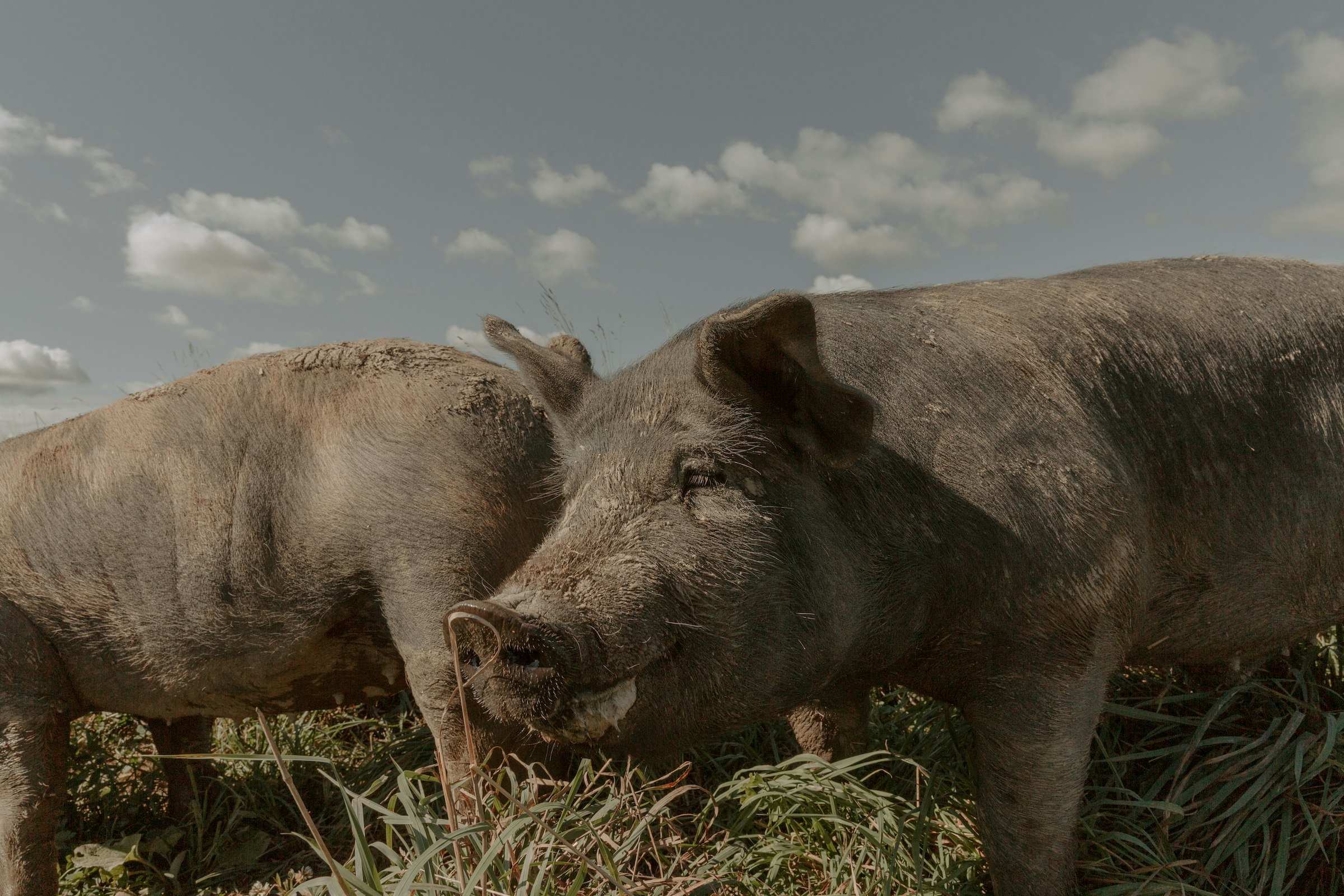
A few days after departing LaGrange I visited the Rodale Institute, an experimental think tank trying to address some aspects of this problem in practical terms. The organization has been a key booster of regenerative agriculture, particularly as a means to fight climate change, and publishes findings from scalable organic farming trial models. Their flagship campus blends into the rolling green of eastern Pennsylvania, a campus of barns and small offices disguised as barns, complete with fading white paint and inauspicious deep green trim. I mainly went to see their pastured hog facility, which has been operating for about six years.
The institute’s setup is built around a central building with rows of indoor pens attached to fenced outdoor paddocks. It’s something of a compromise, with an automated feeding system, central alleyway and overall emphasis on mitigating the labor inputs required to rotate hogs between lots. The arrangement presents a marked improvement from typical confinement conditions but seems far easier to scale and maintain than Greg’s sprawling pastures, explicitly angling for mainstream adoption.
Upon arrival, I was introduced to a homely cast of hogs: Clyde, Petunia, Gilbert and Matilda, the matriarch of a trio of sows that staff affectionately call “the book club.” That their pigs are afforded names is the first obvious sign that Rodale is not a working farm. They send some 100 hogs to market each year (with off-site processing), but are ultimately dependent on research funding rather than market pressures to stay afloat. This affords site operators uniquely close relationships with their hogs — they were intimately familiar with a rivalry stewing between two boars, for example, and one unproductive old sow was permitted to stay alive with the only successful pig from her last litter — but the project can afford to hemorrhage money in a way that no commercial operation could. It does not exactly signal a sound investment to would-be private sector adopters. To date, no commercial farms have implemented the model.
Rodale’s interest in market-friendly reform is ostensibly born of pragmatism, but the industry’s ambivalence ultimately reveals more about the limits of trying to address ethical concerns within the framework of the industry’s overarching bottom-line imperative. By and large, commercial hog farms are not simply waiting around for good-faith proposals to improve confinement conditions under an otherwise relatively streamlined model. To the contrary, the industry’s thrust has been in precisely the opposite direction, and small-scale farmers that might have been sympathetic have largely been dislodged. To accept the bedrock necessity of efficient, profit-maximizing abstraction is to abandon the messy, spiritual, ephemeral upsides of pastured livestock farming. And at the end of the day, these may be its most potent.






